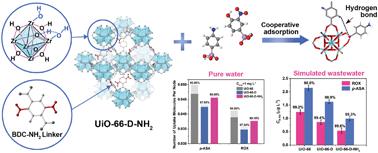当前位置:
X-MOL 学术
›
Environ. Sci.: Nano
›
论文详情
Our official English website, www.x-mol.net, welcomes your
feedback! (Note: you will need to create a separate account there.)
Efficient removal of low-concentration organoarsenic by Zr-based metal–organic frameworks: cooperation of defects and hydrogen bonds
Environmental Science: Nano ( IF 5.8 ) Pub Date : 2019-10-28 , DOI: 10.1039/c9en00923j Yunyun Xu 1, 2, 3, 4, 5 , Jiaxin Lv 1, 2, 3, 4, 5 , Yao Song 1, 2, 3, 4, 5 , Xiaoyu Zhou 6, 7, 8, 9, 10 , Chen Tian 1, 2, 3, 4, 5 , Xujia Hong 5, 11, 12, 13 , Yuepeng Cai 5, 11, 12, 13 , Cunyuan Zhao 6, 7, 8, 9, 10 , Zhang Lin 1, 2, 3, 4, 5
Environmental Science: Nano ( IF 5.8 ) Pub Date : 2019-10-28 , DOI: 10.1039/c9en00923j Yunyun Xu 1, 2, 3, 4, 5 , Jiaxin Lv 1, 2, 3, 4, 5 , Yao Song 1, 2, 3, 4, 5 , Xiaoyu Zhou 6, 7, 8, 9, 10 , Chen Tian 1, 2, 3, 4, 5 , Xujia Hong 5, 11, 12, 13 , Yuepeng Cai 5, 11, 12, 13 , Cunyuan Zhao 6, 7, 8, 9, 10 , Zhang Lin 1, 2, 3, 4, 5
Affiliation

|
As an emerging micropollutant, organoarsenic has caused global ecosystem pollution, due to its degradation to highly toxic inorganic arsenic in the environment. Therefore, to remove the low-concentration organoarsenic from arsenic compounds from water, materials with high adsorption affinity are in urgent need. Herein, we reported an amino-modified metal–organic framework (MOF) with defects (UiO-66-D-NH2) to adsorb two typical organoarsenic forms p-arsanilic acid (p-ASA) and roxarsone (ROX). The adsorption affinity of UiO-66-D-NH2 was 3.8 and 3.0 times higher than that of original UiO-66 and defective UiO-66 without amino modification (UiO-66-D), while the removal rate exceeded 99.1% when the initial concentration of organoarsenic decreased to 1 mg L−1. UiO-66-D-NH2 also showed excellent adsorption behavior in simulated wastewater, with residual arsenic concentrations lower than 0.54 μg L−1. Mechanism studies showed a cooperation of the defects and –NH2 groups in UiO-66-D-NH2. The defects provided more Zr–OH sites in the metal node, leading to transformation of the As–O–Zr coordination from monodentate mononuclear to bidentate binuclear configuration, while –NH2 groups formed hydrogen bonds with both p-ASA and ROX as a secondary interaction to further reinforce the as-formed As–O–Zr complex. This work revealed that making cooperation by defect creation and amino modification could be an effective method to enhance the adsorption affinity of MOFs to low-concentration organoarsenic.
中文翻译:

基于Zr的金属有机框架有效去除低浓度有机砷:缺陷和氢键的协同作用
作为一种新兴的微污染物,有机砷由于在环境中降解为剧毒的无机砷而引起了全球生态系统污染。因此,为了从水中的砷化合物中去除低浓度的有机砷,迫切需要具有高吸附亲和力的材料。在本文中,我们报道了一种氨基修饰的金属有机骨架(MOF),其缺陷(UiO-66-D-NH 2)可以吸附两种典型的有机砷形式的对砷酸(p -ASA)和罗沙酮(ROX)。UiO-66-D-NH 2的吸附亲和力当有机砷的初始浓度降至1 mg L -1时,其去除率比原始UiO-66和未进行氨基修饰的有缺陷的UiO-66分别高3.8和3.0倍,而去除率超过99.1%。UiO-66-D-NH 2在模拟废水中也表现出优异的吸附性能,残留砷浓度低于0.54μgL -1。机理研究表明,UiO-66-D-NH 2中的缺陷与-NH 2基团协同作用。缺陷在金属节点中提供了更多的Zr-OH位点,从而导致As-O-Zr配位从单齿单核转变为双齿双核构型,而-NH 2基团与两个p -ASA和ROX作为辅助相互作用进一步增强了所形成的As-O-Zr配合物。这项工作表明,通过缺陷产生和氨基修饰进行合作可能是增强MOF对低浓度有机砷的吸附亲和力的有效方法。
更新日期:2019-10-28
中文翻译:

基于Zr的金属有机框架有效去除低浓度有机砷:缺陷和氢键的协同作用
作为一种新兴的微污染物,有机砷由于在环境中降解为剧毒的无机砷而引起了全球生态系统污染。因此,为了从水中的砷化合物中去除低浓度的有机砷,迫切需要具有高吸附亲和力的材料。在本文中,我们报道了一种氨基修饰的金属有机骨架(MOF),其缺陷(UiO-66-D-NH 2)可以吸附两种典型的有机砷形式的对砷酸(p -ASA)和罗沙酮(ROX)。UiO-66-D-NH 2的吸附亲和力当有机砷的初始浓度降至1 mg L -1时,其去除率比原始UiO-66和未进行氨基修饰的有缺陷的UiO-66分别高3.8和3.0倍,而去除率超过99.1%。UiO-66-D-NH 2在模拟废水中也表现出优异的吸附性能,残留砷浓度低于0.54μgL -1。机理研究表明,UiO-66-D-NH 2中的缺陷与-NH 2基团协同作用。缺陷在金属节点中提供了更多的Zr-OH位点,从而导致As-O-Zr配位从单齿单核转变为双齿双核构型,而-NH 2基团与两个p -ASA和ROX作为辅助相互作用进一步增强了所形成的As-O-Zr配合物。这项工作表明,通过缺陷产生和氨基修饰进行合作可能是增强MOF对低浓度有机砷的吸附亲和力的有效方法。











































 京公网安备 11010802027423号
京公网安备 11010802027423号